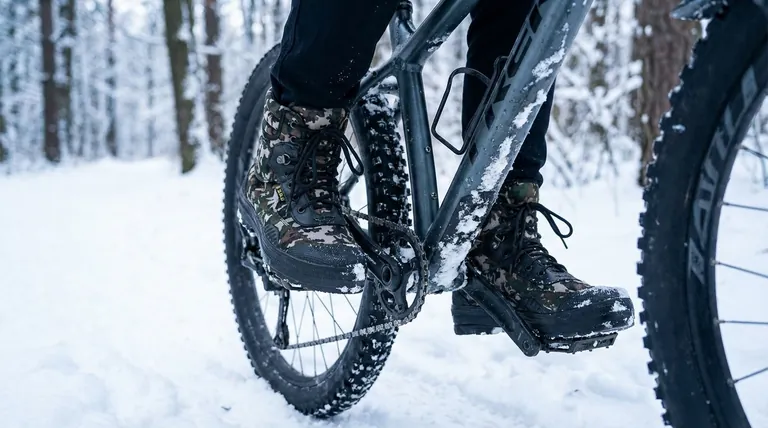For winter cycling, your best alternatives to expensive, bike-specific footwear are insulated winter hiking boots, snowshoeing boots, or even snowmobile boots. These options are often significantly more cost-effective and provide excellent warmth and protection from the elements, especially when paired with flat pedals.
The core issue isn't finding a "cycling" boot, but finding a warm, weather-resistant boot that works effectively with your pedals. Many general-purpose winter boots meet these criteria perfectly, saving you money without compromising comfort on cold rides.

Why Look Beyond Cycling-Specific Boots?
While dedicated winter cycling boots exist, they occupy a niche market with a premium price tag. Understanding the advantages of general winter footwear can help you make a more practical and economical choice.
The Cost and Versatility Advantage
Cycling-specific winter boots can be a significant investment for a single activity. An insulated hiking or snowshoeing boot you already own, or can buy for less, offers far greater versatility for other winter activities.
Evaluating the Top Alternatives
Your goal is to find a boot that balances warmth, water resistance, and compatibility with a bicycle pedal. Several types of general winter boots fit this description well.
Insulated Winter Hiking Boots
These are an excellent starting point and a very popular choice. They typically have a reasonably stiff sole that provides decent power transfer to the pedal. Their insulation is more than adequate for many winter conditions, as your own experience has proven.
Snowshoeing Boots
Snowshoeing boots are a fantastic option. They are engineered to be waterproof, well-insulated, and surprisingly lightweight for the protection they offer. Their balance of features makes them one of the most effective alternatives.
Snowmobile Boots
For the most extreme cold and deep snow conditions, snowmobile boots offer maximum insulation. Their primary drawback is their bulk, which you must consider carefully.
Understanding the Trade-offs
Using non-cycling footwear is a practical solution, but it's important to be aware of the compromises. The key difference lies in the interface between the boot and the pedal.
Pedal Interface and Grip
General winter boots are designed for walking, not gripping pedal pins. They require you to use flat platform pedals. Even then, the deep, aggressive lugs on a hiking or snow boot may not mesh as securely with pedal pins as a dedicated flat-pedal shoe.
Bulk and Crank Clearance
Larger boots, especially snowmobile boots, can be bulky. This can lead to the side of your boot rubbing against the bicycle's crank arms as you pedal, which can be inefficient and annoying. Always check for clearance before committing to a long ride.
Ankle Mobility and Stiffness
Hiking boots are designed to support your ankle for walking on uneven terrain. This can sometimes feel restrictive compared to the more flexible cuff of a cycling shoe designed purely for a pedaling motion.
Making the Right Choice for Your Ride
Selecting the right boot depends entirely on your riding conditions and priorities. There is no single "best" answer, only the best solution for your specific needs.
- If your primary focus is casual rides and maximum value: A good pair of insulated winter hiking boots you already use for other activities is likely the perfect solution.
- If your primary focus is riding in deep snow or extreme cold: Look toward dedicated snowshoeing or snowmobile boots for their superior insulation and weather protection.
- If your primary focus is maintaining pedaling efficiency: While alternatives work well, a cycling-specific boot will offer the stiffest sole and best pedal interface, but at a significant cost premium.
Ultimately, choosing the right footwear empowers you to ride comfortably and safely through the coldest months.
Summary Table:
| Boot Type | Best For | Key Considerations |
|---|---|---|
| Insulated Winter Hiking Boots | Casual rides, maximum value | Good warmth, stiff sole for power transfer, versatile |
| Snowshoeing Boots | Deep snow, wet conditions | Excellent waterproofing, lightweight, great insulation |
| Snowmobile Boots | Extreme cold, maximum warmth | Bulky, check crank clearance, best for severe cold |
Ready to gear up for winter?
As a large-scale manufacturer, 3515 produces a comprehensive range of durable and weather-resistant footwear perfect for all your cold-weather activities, including cycling. We work directly with distributors, brand owners, and bulk clients to provide high-quality boots that combine warmth, protection, and value.
Let us help you find or create the perfect winter boot solution. Contact our team today to discuss your needs!
Visual Guide

Related Products
- Wholesale High-Traction Camo Boots - Custom Manufacturer for Brands
- Factory-Direct Wholesale Canvas Boots with High-Traction Rubber Soles
- High Performance Fire-Retardant Waterproof Safety Boots
- Premium Wholesale Waterproof Safety Boots High Performance Protection for Industrial Markets
- Factory Direct Wholesale Rain Boots Durable Waterproof & Fully Customizable
People Also Ask
- Are military camouflage boots waterproof? How to Choose Boots That Keep Feet Dry
- What are some real-world applications of military camouflage boots? From Tactical to Trendsetting
- What is the name of the new boot model mentioned in the article? Introducing the Boots Original Camo Red Desert
- Why might wearing multiple pairs of socks be counterproductive? Avoid This Common Cold-Weather Mistake
- What are the key features of the new line of camo boots? Built for Extreme Cold & Rugged Terrain



















